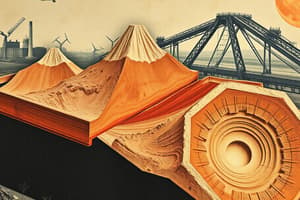Podcast
Questions and Answers
Which of the following is a primary effect of volcanic eruptions?
Which of the following is a primary effect of volcanic eruptions?
- Decreased tourism
- Spread of diseases
- Fertilization of soils (correct)
- Increased trade
What causes earthquakes?
What causes earthquakes?
- The movement of tectonic plates (correct)
- The activity of volcanoes
- The rotation of the Earth
- The shift in the Earth's magnetic field
What is the primary cause of death associated with tsunamis?
What is the primary cause of death associated with tsunamis?
- Spread of diseases
- Contamination of water supplies
- Building collapses
- Drowning (correct)
Flashcards are hidden until you start studying
Study Notes
Plate Tectonics, Volcanoes, and Earthquakes: Understanding the Hazards
- The Earth is composed of the core, mantle, and crust, with the crust being split into plates that move slowly and cause tectonic activity at plate margins.
- There are two types of plates: dense oceanic and less dense thick continental, and their movement causes hazards like earthquakes and volcanoes.
- The plates move due to either convection currents in the mantle or the weight of heavier denser plates sinking into the mantle and dragging other sections of the plate with it.
- Volcanic eruptions have primary effects like the destruction of buildings and secondary effects like homelessness and climate change.
- Volcanoes occur at unstable plate boundaries or in the middle of plates where the crust is thin or where there is a hot spot in the mantle.
- Primary effects of volcanic eruptions include lava flow, pyroclastic flows, and ash fall, while secondary effects include blocked roads and positive effects like fertilization of soils.
- Earthquakes occur when two tectonic plates push together, and the pressure builds up inside the Earth’s crust until it is suddenly released as seismic waves that cause the ground to shake.
- Primary effects of earthquakes include building collapses, blocked roads, and broken pipes, while secondary effects include high costs of rebuilding, decreased trade, and spread of diseases.
- Tsunamis, caused by earthquakes at sea, can travel up to 800 km/h and cause flooding and destruction of homes.
- The majority of deaths associated with tsunamis are caused by drowning, and the flooding can contaminate water supplies.
- Planning, predicting, and preparing can reduce the effects of volcanic eruptions and earthquakes.
- Understanding plate tectonics, volcanoes, and earthquakes is crucial for mitigating their hazards and protecting communities and the environment.
Studying That Suits You
Use AI to generate personalized quizzes and flashcards to suit your learning preferences.




